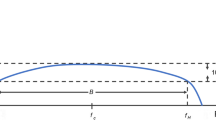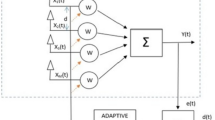Abstract
In this paper, we investigate robust design methods for broadband beamformers in reverberant environments. In the design formulation room reverberation as well as robustness to amplitude and phase mismatches in the microphones have been included. Particularly, the direct path and the reflections are separated in the design such that there is a penalty on the reflective part. This approach is different from the commonly studied problem of dereverberation of a single point source as the investigated design is made over a region in space. A single point derverberation is not a very practical approach due to a high sensitivity to position changes. Thus in order to obtain more practical microphone array designs, we study methods that optimize performance over areas in space. The design problem has been formulated in four different ways; (i) using direct path only representing a traditional beamformer design method, (ii) using a robust design method which considers robustness against the microphone characteristics (gain and phase) by optimizing the mean performance, (iii) by including room impulse response in the design and finally, (iv) using both robustness and room impulse response in the design. Simulation results show that robust direct path based beamformer can achieve approximately the same performance as including room response in the design in many reverberation environments. The proposed method provides robustness over larger variations in the reverberation environment. This means that the robust direct path based method which is based on mean variations in gain and phase can be used in low- to medium (\(T_{60}\) = 100–300 ms) reverberant environments with good result.









Similar content being viewed by others
References
Abhayapala, T. D., Kennedy, R. A., Williamson, R. C., & Ward, D. B. (1999). Nearfield broadband adaptive beamforming. In Proceedings of the fifth international symposium on signal processing and its applications, Vol. 2, pp. 839–842.
Allen, J. B., & Berkley, D. A. (1979). Image method for efficiently simulating small-room acoustics. The Journal of the Acoustical Society of America, 65(4), 943–950.
Cauchi, B., Kodrasi, I., Rehr, R., Gerlach, S., Jukić, A., Gerkmann, T., et al. (2015). Combination of mvdr beamforming and single-channel spectral processing for enhancing noisy and reverberant speech. EURASIP Journal on Advances in Signal Processing, 2015(1), 61.
Chen, H., Ser, W., & Yu, Z. L. (2007). Optimal design of nearfield wideband beamformers robust against errors in microphone array characteristics. IEEE Transactions on Circuits and Systems I: Regular Papers, 54(9), 1950–1959.
Dam, H. H., & Nordholm, S. (2013). Design of robust broadband beamformers with discrete coefficients and least squared criterion. IEEE Transactions on Circuits and Systems II: Express Briefs, 60(12), 897–901.
Doclo, S. (2003). Multi-microphone noise reduction and dereverberation techniques for speech applications. Ph.D. dissertation, Department of Electrical Engineering, Katholieke Universiteit Leuven, Leuven.
Doclo, S., Kellermann, W., Makino, S., & Nordholm, S. E. (2015). Multichannel signal enhancement algorithms for assisted listening devices: Exploiting spatial diversity using multiple microphones. IEEE Signal Processing Magazine, 32(2), 18–30.
Doclo, S., & Moonen, M. (2003). Design of broadband beamformers robust against gain and phase errors in the microphone array characteristics. IEEE Transactions on Signal Processing, 51(10), 2511–2526.
Feng, Z. G., Yiu, K. F. C., & Nordholm, S. (2012). Placement design of microphone arrays in near-field broadband beamformers. IEEE Transactions on Signal Processing, 60(3), 1195–1204.
Frost, O. L. (1972). An algorithm for linearly constrained adaptive array processing. Proceedings of the IEEE, 60(8), 926–935.
Habets, E. A., & Benesty, J. (2013). A two-stage beamforming approach for noise reduction and dereverberation. IEEE Transactions on Audio, Speech, and Language Processing, 21(5), 945–958.
Hadad, E., Heese, F., Vary, P., & Gannot, S. (2014). Multichannel audio database in various acoustic environments. In 14th international workshop on acoustic signal enhancement (IWAENC), pp. 313–317.
Khalid, L., Nordholm, S., & Dam, H. (2015). Design study on microphone arrays. In IEEE international conference on digital signal processing (DSP), pp. 1171–1175.
Kuttruff, H. (2009). Room acoustics. Boca Raton: CRC Press.
Lehmann, E. A., & Johansson, A. M. (2008). Prediction of energy decay in room impulse responses simulated with an image-source model. The Journal of the Acoustical Society of America, 124(1), 269–277.
Li, Z., Yiu, K. F. C., & Nordholm, S. E. (2014). On the indoor beamformer design with reverberation. IEEE/ACM Transactions on Audio, Speech, and Language Processing, 22(8), 1225–1235.
McCowan, I. A., Marro, C., & Mauuary, L. (2000). Robust speech recognition using near-field superdirective beamforming with post-filtering. In ICASSP, pp. 1723–1726.
Nahma, L., Dam, H. H. D., & Nordholm, S. (2018). Robust beamformer design against mismatch in microphone characteristics and acoustic environments. In 16th international workshop on acoustic signal enhancement (IWAENC).
Naylor, P. A., & Gaubitch, N. D. (2010). Speech dereverberation. Berlin: Springer.
Naylor, P. A., Gaubitch, N. D., & Habets, E. A. (2010). Signal-based performance evaluation of dereverberation algorithms. Journal of Electrical and Computer Engineering, 2010, 1.
Nordebo, S., Claesson, I., & Nordholm, S. (1994). Adaptive beamforming: Spatial filter designed blocking matrix. IEEE Journal of Oceanic Engineering, 19(4), 583–590.
Nordholm, S., Dam, H., Lai, C., & Lehmann, E. (2014). Broadband beamforming and optimization. In A. M. Zoubir (Ed.), Academic Press Library in signal processing: Array and statistical signal processing (Vol. 3, pp. 553–598). Massachusetts: Elsevier.
Nordholm, S., Rehbock, V., Tee, K., & Nordebo, S. (1998). Chebyshev optimization for the design of broadband beamformers in the near field. IEEE Transactions on Circuits and Systems II: Analog and Digital Signal Processing, 45(1), 141–143.
Quackenbush, S. R. (1986). Objective measures of speech quality (subjective). Doctoral dissertation, Georgia Institute of Technology, Atlanta, GA.
Rimantho, D., Dam, H. H. H., & Nordholm, S. (2012). Design of low complexity robust broadband beamformers with least squared performance criterion. Advances in Information Technology and Applied Computing, 1, 4650.
Ryan, J. G., & Goubran, R. A. (2000). Array optimization applied in the near field of a microphone array. IEEE Transactions on Speech and Audio Processing, 8(2), 173–176.
Van Veen, B. D., & Buckley, K. M. (1988). Beamforming: A versatile approach to spatial filtering. IEEE ASSP Magazine, 5(2), 4–24.
Yang, B. (2007). Different sensor placement strategies for tdoa based localization. In IEEE international conference on acoustics, speech and signal processing, 2007. ICASSP, Vol. 2, pp. II-1093–II-1096.
Yiu, K. F. C., Yang, X., Nordholm, S., & Teo, K. L. (2003). Near-field broadband beamformer design via multidimensional semi-infinite-linear programming techniques. IEEE Transactions on Speech and Audio Processing, 11(6), 725–732.
Zee, M. S., & Park, H. M. (2009). Speech dereverberation based on blind estimation of a reverberation filter. IEICE Electronics Express, 6(20), 1456–1461.
Zhao, Y., & Liu, W. (2013). Robust fixed frequency invariant beamformer design subject to norm-bounded errors. IEEE Signal Processing Letters, 20(2), 169–172.
Zhao, Y., Liu, W., & Langley, R. (2011). Application of the least squares approach to fixed beamformer design with frequency-invariant constraints. IET Signal Processing, 5(3), 281–291.
Zheng, Y. R., Goubran, R. A., & El-Tanany, M. (2004). Robust near-field adaptive beamforming with distance discrimination. IEEE Transactions on Speech and Audio Processing, 12(5), 478–488.
Acknowledgements
This work was supported by the Australian Research Councils Discovery Projects funding scheme under Grant DP170104854. Cedric Yiu is supported by RGC Grant PolyU. 152200/14E and PolyU Grant 4-ZZGS and G-YBVQ.
Author information
Authors and Affiliations
Corresponding author
Additional information
Publisher's Note
Springer Nature remains neutral with regard to jurisdictional claims in published maps and institutional affiliations.
Rights and permissions
About this article
Cite this article
Nahma, L., Dam, H.H., Yiu, C.K.F. et al. Robust broadband beamformer design for noise reduction and dereverberation. Multidim Syst Sign Process 31, 135–155 (2020). https://doi.org/10.1007/s11045-019-00649-4
Received:
Revised:
Accepted:
Published:
Issue Date:
DOI: https://doi.org/10.1007/s11045-019-00649-4




